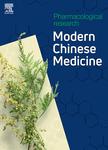版权所有:内蒙古大学图书馆 技术提供:维普资讯• 智图
内蒙古自治区呼和浩特市赛罕区大学西街235号 邮编: 010021

作者机构:BNLMS Peking-Tsinghua Center for Life Sciences at College of Chemistry and Molecular Engineering Peking University Beijing 100871 China PTN Graduate Program Academy for Advanced Interdisciplinary Studies Peking University Beijing 100871 China Center for Quantitative Biology Academy for Advanced Interdisciplinary Studies Peking University Beijing 100871 China Research Unit of Drug Design Method Chinese Academy of Medical Sciences (2021RU014) Beijing 100871 China
出 版 物:《Pharmacological Research - Modern Chinese Medicine》 (Pharmacol Res.)
年 卷 期:2022年第5卷
基 金:Tsinghua Institute of Multidisciplinary Biomedical Research Ministry of Science and Technology of the People's Republic of China, MOST, (2016YFA0502303) Ministry of Science and Technology of the People's Republic of China, MOST Tsinghua University, THU Chinese Academy of Medical Sciences, CAMS, (2021-I2M-5-014) Chinese Academy of Medical Sciences, CAMS National Institute of Agrobiological Sciences, NIAS Peking University, PKU
主 题:Amplitude Circadian clock Clock-enhancing molecule (CEMs) CRY1 Silybin A Silymarin
摘 要:Circadian clock governs a large array of physiological and metabolic functions. The amplitude decline of circadian rhythm is associated with various chronic diseases. However, few clock enhancing-molecules are known. CRY1 is one of the main components of the core circadian clock and its binding with CLOCK leads to decreased transcriptional activity. Thus, compounds interfering with CRY1-CLOCK interaction may enhance circadian rhythm. Natural products are rich sources of drug discovery and herb-based virtual screen provides an efficient way to identify active herbs. Here, by performing herb-based virtual screen against the CLOCK interacting pocket in CRY1 and cell-based assays, we found that Silybum marianum, a widely used medical plant, can activate circadian clock transcription. Molecular level studies showed that its extract silymarin can bind to CRY1 and disrupt CRY1-CLOCK interaction. Further computational and experimental analysis revealed that silybin A is the main bioactive compound that enhances the amplitude of circadian rhythm by reducing the negative arm of the transcription/translation feedback loop. Silybum marianum and its main extract, silymarin, were reported to have hepatoprotective, cardiovascular-protective, antidiabetic, anti-inflammatory, antioxidative, and anti-cancer effects with unclear mechanism. Our study revealed that silymarin and the purified compound silybin A may perform their pharmacological functions by modulating circadian clock. We also demonstrate that disrupting CRY1-CLOCK interaction provides a new route for upregulating circadian rhythm and the CLOCK binding site in CRY1 serves as a druggable pocket for discovering clock enhancing molecules for treating related diseases. © 2022 The Authors